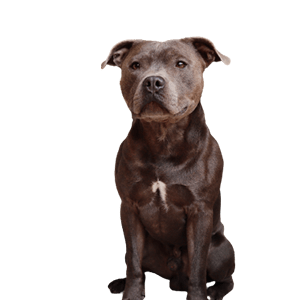American StaffordshireTerrier

The American Staffordshire Terrier and the Staffordshire Bull Terrier descended from the identical lines. The first dog initially sprang from blending the old kind of Bulldog with a few old terrier types, likely the English Smooth Terrier. The result became aptly known as the Bull and Terrier, later dubbed the Staffordshire Bull Terrier. They received passage to America in the 1800s, becoming called the Pit Bull Terrier, American Bull Terrier, or even Yankee Terrier. Americans preferred a slightly larger dog than the English preferred, and the two strains diverged with time. In 1936, the AKC identified the breed as the Staffordshire Terrier (the name was modified in 1972 to American Staffordshire Terrier). The Am Staff developed to have a sweet and sincere disposition around human beings. Unfortunately, those dogs have occasionally appealed to human beings seeking them for their strength instead of their loving abilities. Beginning in the 1980s, Am Staffs often found themselves the target of breed-precise legal guidelines to ban or control certain varieties of dogs. Despite this, the Am Staff is extraordinarily famous amongst people trying a humans- and fun-loving dog.
- Type - Terrier
- Weight -57-67 lb
- Height- 17-19"
- Family -Terrier, Mastiff, Bull
- Date of Orgin-1800s
- Area of Orgin -United States
Energy Level
Exercise Requirements
Playfulness
Affection Level
Friendliness To Dogs
Friendliness To Other Pets
Friendliness To Strangers
Watchfulness
Ease of Training
Grooming Requirements
Heat Sensitivity
Vocality
Temperement
Typically obedient and playful with their family, American Staffordshire Terriers are generally friendly towards strangers as Tralong as their family is present. They usually are excellent with children. They are a protecting breed and should be introduced to new puppies carefully. They are stubborn, tenacious, and fearless. For all in their tough persona, the most vital aspect of life to this breed is their family’s fond attention. Training of the puppy is remarkable.
Upkeep
Am Staffs need a regular outlet for their energy, mostly in a long walk on a leash or an active game in the backyard. Coat caring is minimal.
Health
“Major diagnosis: CHD, cerebellar ataxia, PRA
Minor diagnosis: elbow dysplasia, heart disease, hypothyroidism
Occasionally seen: cruciate ligament rupture, allergies, hypothyroidism
Suggested tests: cardiac, (elbow), thyroid, eye, hip, DNA for ataxia
Life span: 12–14 years
Note: CHD seldom causes problems or symptoms in this breed.”
Disclaimer
Note: While the characteristics mentioned here may frequently represent this breed, dogs are individuals whose personalities and appearances will vary. Please consult the adoption organization for details on a specific pet.
